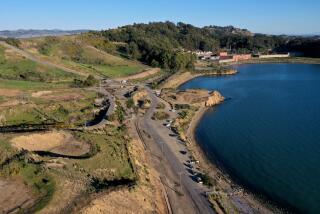Once a Free-Spirited Outpost, Stiltsville Now on Its Last Legs
- Share via
MIAMI — Like long-legged wading birds, houses perched on pilings rise improbably from the sand flats in the middle of Biscayne Bay, pastel-painted symbols of a free-spirited lifestyle that is all but gone.
From its beginnings in the 1930s, the community known as Stiltsville had a reputation as an offshore outpost where lazy days in the sun turned into long nights of revelry. At roughhouse joints such as the Bikini Club and the Quarter Deck Club, booze, gambling and even prostitution were said to be as common as cormorants.
In recent years, the Stiltsville houses have been used as weekend retreats by a small group of Miamians who hold leases on the properties, lending them on occasion for Chamber of Commerce socials or private parties. In 1992, for example, Sen. Edward M. Kennedy (D-Mass.) held his engagement party here.
But time and tide have taken a toll. What was once a community of 25 to 30 wooden cottages is down to seven. And these survivors are on their last legs.
The National Park Service has set a Dec. 1 deadline for leaseholders to hand over the keys. In 1980, the boundaries of Biscayne National Park were redrawn to include the storied collection of ramshackle vacation homes and party shacks, and park managers have made it clear that Stiltsville is not welcome. The last lease agreement expired in July 1999, but leaseholders were permitted to continue using the houses during negotiations with the Park Service.
“Eventually, they will be gone--make no bones about that,” park superintendent Linda Canzanelli said.
She said the houses cast shadows that have killed sea grass, and they pose a navigational hazard and violate an American ethic of fairness. Why, Canzanelli asks, should a privileged few have private rights to property on federal lands?
For years, the leaseholders, as well as thousands of other supporters, have fought to preserve Stiltsville by having the buildings listed on the “National Register of Historic Places.” U.S. Rep. Ileana Ros-Lehtinen (R-Fla.) also has proposed cutting the four-acre Stiltsville community out of the park in exchange for another piece of bay further south.
A leaseholders group, Save Old Stiltsville, has waged a vigorous lobbying effort, enlisting support from Florida Gov. Jeb Bush, collecting 72,000 signatures on petitions, gathering endorsements from writers and celebrities and operating a Web page (https://www.stiltsville.org) that touts the community’s historic importance.
Graham Backs U.S. Plan
But those efforts have failed. Last month, Sen. Bob Graham, the Florida Democrat considered the key to any congressional action on Stiltsville, backed the Park Service plan.
“In two years, Stiltsville will be gone,” architect Gail B. Baldwin lamented last week from the deck of the one-bedroom wooden house he has used for weekend getaways for nearly 30 years. As the sun dropped toward the horizon, a school of snapper played around the pilings, a pelican cruised by and a gentle breeze rocked the aging motorboat that Baldwin uses to commute from his apartment in Coconut Grove, just eight miles--but a world away--to the north.
“We don’t believe the federal government has any intention of maintaining these properties,” Baldwin said. “They will just let them fall.”
Canzanelli vowed that with grants, private donations and discretionary funds in the park’s annual $3-million budget, the houses will be maintained, at least “until they are removed by the hand of God.”
“I know there is a lot of emotion there. These structures are important to many people,” said Canzanelli, 44, who inherited the long-simmering Stiltsville brouhaha when named superintendent two months ago. “But I assume that we will be able to maintain them, and that eventually a storm will take them down.”
Within weeks, Canzanelli said, structural engineers will assess the houses’ integrity while a 23-member advisory committee is being formed to come up with ideas on how to make the houses available to the public. The homes could be converted to vacation rentals or science labs, she said.
‘We Will Resist’
But Stiltsville activists are bitter. “The park’s plan is a ruse, a farce on the American public,” said Duff Matson, who with Miami lawyer Bill Tuttle tried to negotiate a new lease agreement on behalf of Save Old Stiltsville. “This is made to look like it’s for everyone. But the houses will be smashed, vandalized and eventually torn down.”
Despite the looming eviction deadline, Baldwin said he remains hopeful that his days of watching the sunset from his Stiltsville porch are not about to end. “This house is more important to me than anything else I have,” said Baldwin, 63, who estimated the annual cost of maintaining a Stiltsville house at $20,000. “We will resist until the last minute.”
That resistance, Baldwin hints, is more likely to be a court challenge of the eviction order than physical defiance. But, he added, “We have had plenty of people volunteer to lash themselves to the pilings.
“We have strong feelings about preserving these houses for ourselves, our family and for Miami. They represent the way Florida was, a uniqueness that shouldn’t go away.”
*
Times researcher Anna M. Virtue contributed to this story.
More to Read
Sign up for The Wild
We’ll help you find the best places to hike, bike and run, as well as the perfect silent spots for meditation and yoga.
You may occasionally receive promotional content from the Los Angeles Times.






